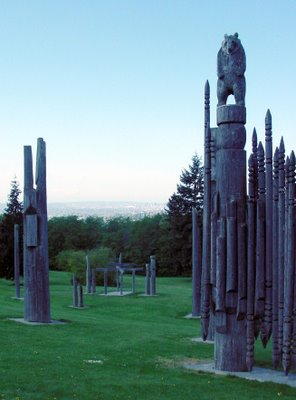A Visit To Burnaby Mountain
In May, my brother, who came Out West to visit with his sisters, and I visited a few local scenic spots. Today, I’ll talk about our visit to Burnaby Mountain Park.
It was a great day for touring around, sunny and neither too cold nor too hot. We drove up Burnaby Mountain, through the SFU campus and then around to the west side of the peak where Horizons Restaurant and Burnaby Mountain Park are.

From the parking lot you have great views to the west of Burrard Inlet, Burnaby and downtown Vancouver. On a really clear day (we had some haze) you can easily see the Lion’s Gate Bridge crossing from Stanley Park to the North Shore.

On the north side of the Park, behind a low fence, there’s a sheer drop pretty much straight down to the Barnet Highway and Burrard Inlet. In this photo you can just make out BC Hydro’s Burrard Thermal Generation Power Plant on the other side of the Inlet. This is a 950 MW conventional natural gas-fired generating station with a capacity of 7,050 gigawatt hours per year. It provides back-up for the hydroelectric system during low water years and also supports the Lower Mainland’s transmission and electrical supply system. I tried to find some more detailed information about this power plant but it seems that it’s been pretty much purged from the web, for security reasons I guess…

This next picture shows Indian Arm angling northward from Burrard Inlet. Indian Arm is a steep 18-mile fjord. While the part of Indian Arm directly across from Burnaby Mountain can be reached by car (Deep Cove), most of it is only accessible by boat.

Burnaby Mountain Park has an impressive totem pole display – good for dramatic photographs. Actually it’s a sculpture called the Playground of the Gods created by Japanese artists, not West Coast totem poles, but whatever, I really like them no matter who made them.
You can see my brother in the first of these shots.



Kamui Mintara, or Playground of the Gods: Sculpted by Japanese artist Nubuo Toko and his son Shusheo. The poles represent the story of the gods who descended to earth to give birth to the Ainu, Japan's first inhabitants.

0 Comments:
Post a Comment
<< Home